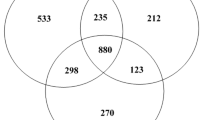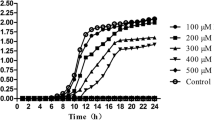Abstract
The antibiotics resistance phenomena of Aeromonas hydrophila has become serious economic and public health problems for the world aquaculture industry and human health care. In this study, to investigate the instinct antibiotics adaptive mechanism of this pathogen, iTRAQ (Isobaric Tags for Relative and Absolute Quantitation) based quantitative proteomics technologies were performed to compare the differential expression of A. hydrophila in planktonic status in response to chlortetracycline (CTC) stress and then identified total 1552 proteins including 285 altered proteins with 90 increasing and 195 decreasing abundance proteins. The following bioinformatics analysis showed that many metabolic metabolism pathways such as carbon metabolism, pyruvate metabolism, and glycolysis/gluconeogenesis were trend to down-regulated whereas β-Lactam resistance, RNA degradation, and amino acids biosynthesis processes were more likely to increase in CTC stress. The related pyruvate metabolism and β-Lactam resistance processes in mRNA level were further measured using the q-PCR method. Thus, an understanding of the behaviors of A. hydrophila in response to CTC would be helpful to reveal the antibiotics adaptive mechanism and for the development of novel antibiotics therapy.
Graphical Abstract






Similar content being viewed by others
References
Aravena-Roman M, Inglis TJ, Henderson B, Riley TV, Chang BJ (2012) Antimicrobial susceptibilities of Aeromonas strains isolated from clinical and environmental sources to 26 antimicrobial agents. Antimicrob Agents Chemother 56:1110–1112. doi:10.1128/AAC.05387-11
Cabello FC, Godfrey HP, Tomova A, Ivanova L, Dolz H, Millanao A, Buschmann AH (2013) Antimicrobial use in aquaculture re-examined: its relevance to antimicrobial resistance and to animal and human health. Environ Microbiol 15:1917–1942. doi:10.1111/1462-2920.12134
Del Castillo CS, Hikima J, Jang HB, Nho SW, Jung TS, Wongtavatchai J, Kondo H, Hirono I, Takeyama H, Aokia T (2013) Comparative sequence analysis of a multidrug-resistant plasmid from Aeromonas hydrophila. Antimicrob Agents Chemother 57:120–129. doi:10.1128/AAC.01239-12
Deng YT, Wu YL, Tan AP, Huang YP, Jiang L, Xue HJ, Wang WL, Luo L, Zhao F (2014) Analysis of antimicrobial resistance genes in Aeromonas spp. isolated from cultured freshwater animals in China. Microbial Drug Resis 20:350–356. doi:10.1089/mdr.2013.0068
Desbonnet C, Tait-Kamradt A, Garcia-Solache M, Dunman P, Coleman J, Arthur M, Rice LB (2016) Involvement of the eukaryote-Like kinase-phosphatase system and a protein that interacts with penicillin-binding protein 5 in emergence of cephalosporin resistance in cephalosporin-sensitive class A penicillin-binding protein mutants in Enterococcus faecium. mBio 7:e02188-15. doi:10.1128/mBio.02188-15
Du D, Wang Z, James NR, Voss JE, Klimont E, OheneAgyei T, Venter H, Chiu W, Luisi BF (2014) Structure of the AcrAB-TolC multidrug efflux pump. Nature 509:512–515. doi:10.1038/nature13205
He Y, Wang K, Zhao X, Zhang Y, Ma Y, Hu J (2016) Differential proteome association study of freeze-thaw damage in ram sperm. Cryobiology 72:60–68. doi:10.1016/j.cryobiol.2015.11.003
Hossain MJ, Sun D, McGarey DJ, Wrenn S, Alexander LM, Martino ME, Xing Y, Terhune JS, Lilesa MR (2014) An Asian origin of virulent Aeromonas hydrophila responsible for disease epidemics in United States-farmed catfish. mBio 5:e00848–00814. doi:10.1128/mBio.00848-14
Huddleston JR, Zak JC, Jeter RM (2006) Antimicrobial susceptibilities of Aeromonas spp. isolated from environmental sources. Appl Environ Microbiol 72:7036–7042. doi:10.1128/AEM.00774-06
Khalil D, Becker CA, Tardy F (2016) Alterations in the quinolone resistance-determining regions and fluoroquinolone resistance in clinical isolates and laboratory-derived mutants of Mycoplasma bovis: Not all genotypes may be equal. Appl Environ Microbiol 82:1060–1068. doi:10.1128/AEM.03280-15
Ko WC, Yu KW, Liu CY, Huang CT, Leu HS, Chuang YC (1996) Increasing antibiotic resistance in clinical isolates of Aeromonas strains in Taiwan. Antimicrob Agents Chemother 40:1260–1262
Li H, Lin XM, Wang SY, Peng XX (2007) Identification and antibody-therapeutic targeting of chloramphenicol-resistant outer membrane proteins in Escherichia coli. J Proteome Res 6:3628–3636. doi:10.1021/pr070307y
Li WX, Yao ZJ, Sun LN, Hu WJ, Cao JJ, Lin WX, Lin X (2016) Proteomics analysis reveals a potential antibiotic cocktail therapy strategy for Aeromonas hydrophila infection in biofilm. J Proteome Res 15:1810–1820. doi:10.1021/acs.jproteome.5b01127
Lin XM, Kang L, Li H, Peng XX (2014a) Fluctuation of multiple metabolic pathways is required for Escherichia coli in response to chlortetracycline stress. Mol Biosyst 10:901–908. doi:10.1039/c3mb70522f
Lin XM, Yang MJ, Li H, Wang C, Peng XX (2014b) Decreased expression of LamB and Odp1 complex is crucial for antibiotic resistance in Escherichia coli. J Proteomics 98:244–253. doi:10.1016/j.jprot.2013.12.024
Lin XM, Shi M, Masilamoni JG, Dator R, Movius J, Aro P, Smith Y, Zhang J (2015a) Proteomic profiling in MPTP monkey model for early Parkinson disease biomarker discovery. Biochim Biophys Acta 1854:779–787. doi:10.1016/j.bbapap.2015.01.007
Lin XM, Lin L, Yao ZJ, Li WX, Sun LN, Zhang DF, Ji L, Lin WX (2015b) An integrated quantitative and targeted proteomics reveals fitness mechanisms of Aeromonas hydrophila under oxytetracycline stress. J Proteome Res 14:1515–1525. doi:10.1021/pr501188g
Liu XJ, Zhu WC, Su YB, Guo C, Zeng ZH, Zhu H, Li H, Peng XX (2015) Characterization of ampicillin-stressed proteomics and development of a direct method for detecting drug-binding proteins in Edwardsiella tarda. J Proteomics 116:97–105. doi:10.1016/j.jprot.2014.12.018
Lobritz MA, Belenky P, Porter CB, Gutierrez A, Yang JH, Schwarz EG, Dwyer DJ, Khalil AS, Collins JJ (2015) Antibiotic efficacy is linked to bacterial cellular respiration. Proc Natl Acad Sci USA 112:8173–8180. doi:10.1073/pnas.1509743112
Moller TS, Rau MH, Bonde CS, Sommer MO, Guardabassi L, Olsen JE (2016) Adaptive responses to cefotaxime treatment in ESBL-producing Escherichia coli and the possible use of significantly regulated pathways as novel secondary targets. J Antimicrob Chemother. doi:10.1093/jac/dkw198
Peng B, Su YB, Li H, Han Y, Guo C, Tian YM, Peng XX (2015) Exogenous alanine and/or glucose plus kanamycin kills antibiotic-resistant bacteria. Cell Metab 21:249–261. doi:10.1016/j.cmet.2015.01.008
Pridgeon JW, Klesius PH, Mu X, Carter D, Fleming K, Xu D, Srivastava K, Reddy G (2011) Identification of unique DNA sequences present in highly virulent 2009 Alabama isolates of Aeromonas hydrophila. Vet Microbiol 152:117–125. doi:10.1016/j.vetmic.2011.04.008
Schmidt AS, Bruun MS, Dalsgaard I, Larsen JL (2001) Incidence, distribution, and spread of tetracycline resistance determinants and integron-associated antibiotic resistance genes among motile aeromonads from a fish farming environment. Appl Environ Microbiol 67:5675–5682. doi:10.1128/AEM.67.12.5675-5682.2001
Shannon P, Markiel A, Ozier O, Baliga NS, Wang JT, Ramage D, Amin N, Schwikowski B, Ideker T (2003) Cytoscape: a software environment for integrated models of biomolecular interaction networks. Genome Res 13:2498–2504. doi:10.1101/gr.1239303
Singhal R, Reynolds PR, Marola JL, Epperson LE, Arora J, Sarin R, Myneedu VP, Strong M, Salfinger M (2016) Sequence analysis of fluoroquinolone resistance associated genes gyrA and gyrB in clinical Mycobacterium tuberculosis isolates from suspected multidrug-resistant tuberculosis patients in New Delhi, India. J Clin Microbiol. doi:10.1128/JCM.00670-16
Stratev D, Odeyemi OA (2015) Antimicrobial resistance of Aeromonas hydrophila isolated from different food sources: a mini-review. J Infect Public Health. doi:10.1016/j.jiph.2015.10.006
Szklarczyk D, Franceschini A, Wyder S, Forslund K, Heller D, Huerta-Cepas J, Simonovic M, Roth A, Santos A, Tsafou KP, Kuhn M, Bork P, Jensen LJ, von Mering C (2015) STRING v10: protein-protein interaction networks, integrated over the tree of life. Nucleic Acids Res 43:D447–452. doi:10.1093/nar/gku1003
Vally H, Whittle A, Cameron S, Dowse GK, Watson T (2004) Outbreak of Aeromonas hydrophila wound infections associated with mud football. Clinical Infect Dis 38:1084–1089. doi:10.1086/382876
Varela AR, Nunes OC, Manaia CM (2016) Quinolone resistant Aeromonas spp. as carriers and potential tracers of acquired antibiotic resistance in hospital and municipal wastewater. Sci Total Environ 542:665–671. doi:10.1016/j.scitotenv.2015.10.124
Yao ZJ, Wang ZH, Sun LN, Li WX, Shi Y, Lin L, Lin WX, Lin XM (2016) Quantitative proteomic analysis of cell envelope preparations under iron starvation stress in Aeromonas hydrophila. BMC Microbiol 16:161. doi:10.1186/s12866-016-0769-5
Acknowledgements
This work was sponsored by grants from NSFC projects (Nos. 31200105, 31670129 and 31470238), the Fujian Agricultural and Forestry University Foundation for Distinguished Young Scholars (Nos. XJQ201201) and Fujian-Taiwan Joint Innovative Center for Germplasm Resources and cultivation of crop (FJ 2011 Program, No. 2015-75, China).
Author information
Authors and Affiliations
Corresponding authors
Ethics declarations
Conflict of interest
The authors have declared that no competing interests exist.
Electronic supplementary material
Below is the link to the electronic supplementary material.
Rights and permissions
About this article
Cite this article
Li, W., Yao, Z., Zhang, X. et al. Global protein expression profile response of planktonic Aeromonas hydrophila exposed to chlortetracycline. World J Microbiol Biotechnol 33, 68 (2017). https://doi.org/10.1007/s11274-017-2204-y
Received:
Accepted:
Published:
DOI: https://doi.org/10.1007/s11274-017-2204-y




